Cannabis: From The Black Market To The Stock Market
Synopsis: “The Times They Are A-Changin”. With the United Nations removing it from Schedule IV of the 1961 Single Convention on Narcotic Drugs and many US states legalising the medical use of the so called “world’s most misunderstood plant”, Cannabis is slowly but surely coming out of the shadows. As it gradually enters the mainstream, it definitely is bringing along a chain of investors who view the plant as a new investment option. While US and Canada are at the forefront when it comes to investing in cannabis, the emerging markets are also gradually catching up. Cannabis is widely being touted as “the economy plant” for many emerging markets with the potential of creating thousands of jobs for the local population. It is also beneficial for the local industry because of its medicinal and industrial applications. EMAlpha takes a look at the opportunities and challenges that investors could face in EMs as this new cannabis investment theme unfolds.
Cannabis in Human Society
Cannabis or Marijuana has been known to humans for thousands of years. It had common usage as medicine and as an intoxicating agent. It gained further prominence during the hippie culture of the swinging sixties. It was in the 1960s that the UN classified cannabis as a narcotics and put the drug in the banned substances list. The important thing to know about cannabis is that, it has two main components: CBD and THC.
While CBD (Cannabidiol) is primarily used in medical treatments, THC (Tetrahydrocannabinol) is the psychoactive part of the plant that gets one high. It is CBD (which is derived from the hemp plant, a cousin of marijuana plant) that has been legalised in many countries while the recreational use of the drug is still a criminal offence across many parts of the world. Because of severe restrictions it was placed under for decades, there was not much interest in the plant for commercial reasons.
However, this has been an intensely debated subject. Supporters of cannabis say that it is just another plant whose benefits (like its medicinal usage) far outstrips the disadvanatges (abuse as an intoxicating agent). They also claim that it is a much less harmful substance compared to stuff like tobacco and other drugs. But, the critics are naturally not convinced. They say that any relaxation on retrictions that marijuana has been placed under is equivalent to promoting drug abuse.
Legaliszation of Medical Marijuana
In the 1960s, the United Nations classified cannabis as a narcotics and put it in the Schedule IV of the 1961 Single Convention on Narcotic Drugs, where it was listed alongside opioids like heroin. Drugs in Schedule IV are strictly controlled and their unauthorised usage is a criminal offence. But in 2020, the UN decided to remove it from Schedule IV while releasing a statement, acknowledging that subjecting cannabis to the strictest control schedules, discouraged its use for medicinal purposes. With verifiable evidence of the medical benefits of cannabis, its removal from Schedule IV was undoubtedly a big positive step forward.
As of now, Canada and as many as 36 states in the US have legalised the medical use of cannabis. While this has benefited the medical community, there are other implications as well. For example, the investing community has also jumped in on the cannabis bandwagon, sensing this as a lucrative opprtunity to make money.
Market Opportunity for Medical Cannabis
The world over, medical cannabis is used for the treatment of several illnesses and conditions such as chronic pain and nausea, pain management and epilepsy. There is an increasing demand to legalize the use of medical marijuana across major markets in Asia Pacific and the Middle East. The market is expected to grow quickly as a result of medical marijuana turning mainstream.
Medical marijuana market size surpassed USD 22.4 billion in 2020 and is estimated to register over 19.3% CAGR between 2021 and 2027, as per the estimates of Global Market Insights. There’s clearly big money at play here. With healthcare professionals vouching for the benefits of medical marijuana, regulatory authorities have been compelled to consider and legalize medical cannabis. Over 30 countries have already legalized cannabis’ medical use. And as we highlighted in the previous section, several states in the USA have also approved its medical use.
Where do the Emerging Markets stand when it comes to Cannabis?
With increasing use of medical marijuana for pain control, a strong case is being put forth regarding legalising cannabis. Although the topic is sensitive, the least controversial is the extract from the hemp plant known as CBD (cannabidiol). That’s because CBD has little, if any, intoxicating properties.
Marijuana has more than 100 active components. THC (tetrahydrocannabinol) is the chemical that causes the “high” that many people clamour for and that is synonymous with marijuana consumption. CBD-dominant strains have little or no THC. Therefore its consumption causes hardly any alteration in consciousness. It is CBD that is widely being used in medicine as a muscle relaxant.
The developing countries have started to realise that apart from providing medical benefits, cannabis can very well act as an economic booster. The low production costs and suitable natural conditions are conducive for big companies looking at emerging economies for setting shop. Many countries like Uruguay, Argentina, and Thailand have either totally or to a major extent, have already decriminalised cannabis cultivation, possession and usage. We look at some of these countries and the major developments taking shape in more detail.
Uruguay
Although the entire Latin America pack of countries is very high on the economic impact of cannabis, Uruguay took the first initiative and decriminalised both recreational and medical use of marijuana in 2013, thus becoming the first country in the world to do so. Hoping to capitalize on the increasing demand for the plant, Uruguay’s legalisation of marijuana ensured that the black market ceased to thrive.
The Uruguayan government has been much more supportive of businesses growing marijuana for medicinal use and that is what the local companies are trying to capitalise on. Despite a significant head start, Uruguay’s weed economy has been a slow mover. But that has not deterred investors from betting on Uruguay to become an export hub for medical marijuana as the industry grows around the world.
Silverpeak and rival ICC Labs (bought for US$ 217 million by Aurora Cannabis, one of Canada’s most valuable cannabis companies) are among a handful of companies that have put money into Uruguay, investing in greenhouses and extraction labs with a goal of supplying medical cannabis to Europe, Canada and other Latin American countries. Local medicinal cannabis dealer, CannaPur, built a factory in an area of high unemployment to support the local economy. As things are starting to fall in place, the North American cannabis investors are beginning to look at Uruguay as a favourable destination with cannabis exports expected to go beyond US $ 1 billion annually by 2024.
Argentina
On 2nd June 2021, President Alberto Fernández’s administration announced the presentation of a bill to regulate the production of cannabis for medicinal purposes and of hemp (a cousin plant of cannabis), which is used for industrial manufacturing, mainly in the textile sector. According to the announcement, the government is looking at the creation of more than 10,000 jobs over the next three years with plans to boost the domestic market as well as exporting marijuana products.
It is important to note that the proposal is for legalizing cannabis for medicinal purposes and not for recreational use. Sorry smokers!!! Following the government’s announcement, it has been estimated that cannabis could generate 500 million dollars in the Argentine domestic market and 50 million dollars in exports by 2025. Considering the laggards caused by the pandemic, it is clear that the government is counting on cannabis to be one of its economic propellants.
Thailand
Perhaps the country that has best managed to regulate and capitalise on the cannabis revolution is Thailand. With the government legalising commercial growing in the country last year to promote hemp and cannabis as new cash crops, many categories of goods and products ranging from mouth spray, skincare products, energy drinks to painkillers and spa products are cashing in on cannabis’ hype.
With the new legislation, Thai households can now grow up to six pots of cannabis each to supplement their income by supplying the crop to public hospitals and state facilities, or use them to make food and cosmetic products. It doesn’t come as a surprise therefore that stocks with a connection to hemp-related businesses have seen a consistent rise this year as investors are bullish on the future of the hemp industry following the government’s positive stamp. Cannabis is increasingly being seen as a new cash crop that could bring investments into Thailand. Again, it is important to note that the recreational use of marijuana is still banned in Thailand.
By 2024, it is estimated that the market value of cannabis in Thailand will be between US $ 660 million and US $ 2.5 billion. It is clear that the ‘green gold’ certainly has takers. With cannabis acting as an economy engine, many businesses and investors are turning to research and development of products made from marijuana. Medical product development, breed selection, cultivation are all going on full swing as the cannabis economy readies itself for a major jump forward. Thailand is clearly ready to become “High-land”.
Famous Names in the Marijuana Game
Cannabis or marijuana or weed or pot has always been fashionable but punishable by law. It is no secret that many rock and roll artists have been marijuana smokers for decades. The mind altering experience of recreational marijuana has acted as fodder for many great artists. As countries have started legalising cannabis, many musicians, athletes and businessmen are not shying away from getting involved in the marijuana business.
Paypal’s co-founder Peter Thiel was one of the first to ride the wave. In 2015, Founders Fund, the $2 billion San Francisco venture capital firm run by Silicon Valley stars including himself, invested in Privateer Holdings, a marijuana company that owns several pot-related brands. Seattle based Privateer owns the Canadian medical marijuana producer Tilray as well as the pot information service Leafly.
Billionaire Beau Wrigley, heir to the vast Wrigley chewing gum fortune, is building his cannabis company, Parallel. He is in fact projecting it to be bigger than his family’s chewing gum business. With an objective to build the first mainstream marijuana brand, Wrigley has hired executives and advisors from some of the largest and best-known corporations in the world.
Whoopi Goldberg, the famous American TV personality, lent her name and financial backing to a new line of medical marijuana products designed specifically for women. The company she co-founded offers four products: a balm, a tincture, sipping chocolate, and a bath soak. These are infused with marijuana and aim to reduce the pain and cramps from periods.
Mike Tyson, the former boxing heavyweight champion, famous for his first round knockouts, has been selling cannabis products since 2016 through his Tyson Holistic label. ‘Iron Mike’, as he is famously known, is building a weed-themed holiday resort. Aside from a luxury hotel, there will also be a Tyson University on site that will aim to teach cannabis cultivation tips to wannabe farmers.
It is clear that many famous personalities are dipping their toes in this new cannabis revolution that is taking place the world over. The hype is real and the potential is huge.
Performance of Marijuana related Stocks over the past Five years
In general, the Cannabis stocks have performed well over last few years barring a few exceptions. More importantly, the way interest is developing in these companies, the good run is expected to continue. Naturally, there will be differences based on operating and financial performance of individual companies and their tack record on ESG, but the macro environment is conducive.
The following are stock price charts of a few marijuana related stocks over the past five years.
Fig 1: GrowGeneration Corp Stock price (Hydroponic and Organic Garden center supplier) – 5 years
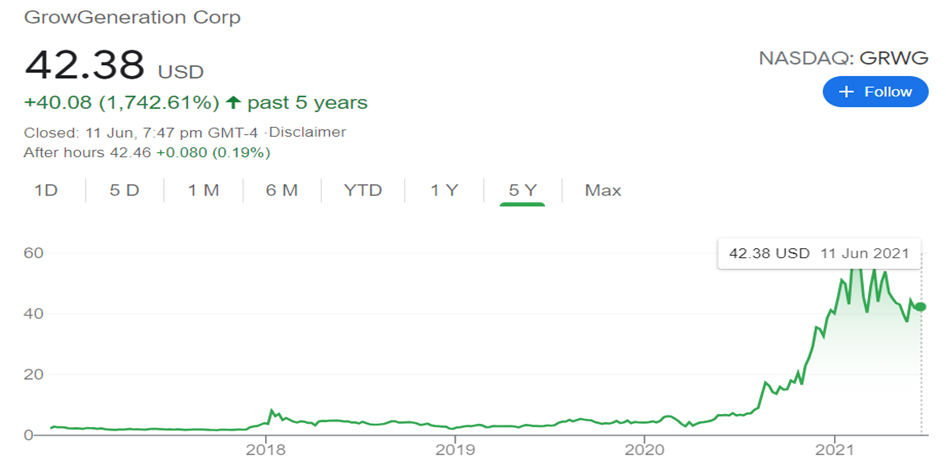
Source: Google
Fig 2: Stock Price of Trulieve Cannabis Corp (Marijuana grower and retailer) – From Sept 2018
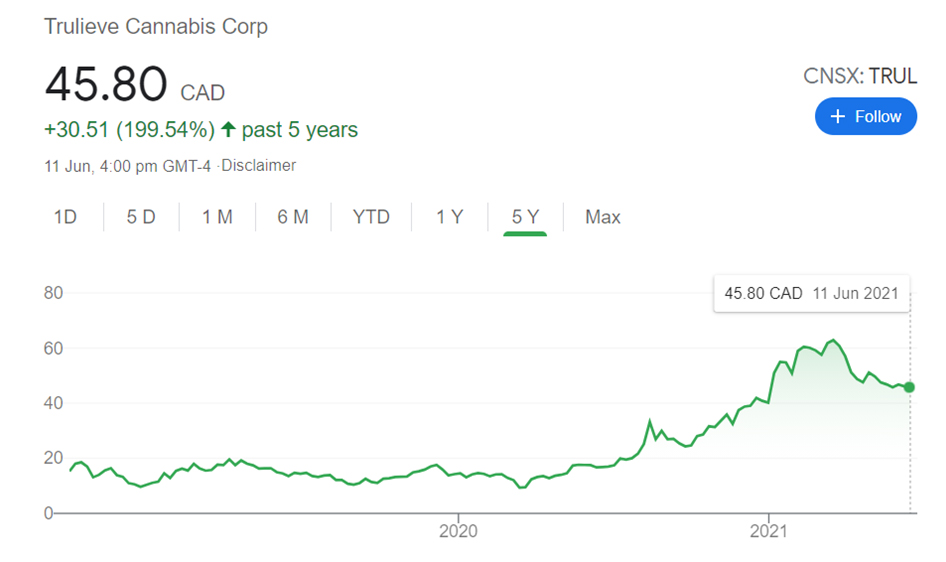
Source: Google
Fig 3: Stock Price of Tilray Inc (Pharmaceutical and Cannabis Company) – From July 2018
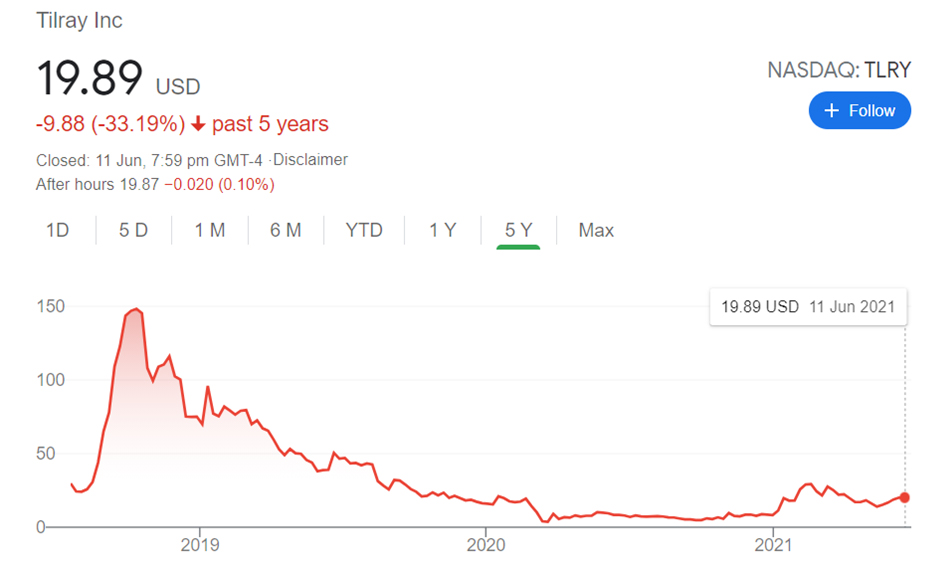
Source: Google
Fig 4: Stock Price of Green Thumb Industries (Marijuana grower and retailer) – 5 years
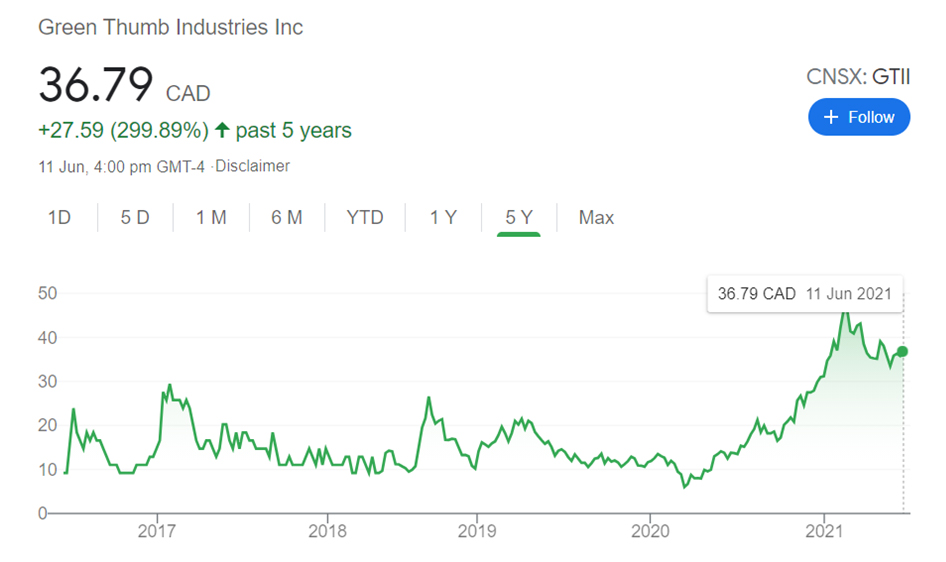
Source: Google
Fig 5: Stock Price of Innovative Industrial Properties (Leading provider of real-estate capital for medical use cannabis industry) – 5 years
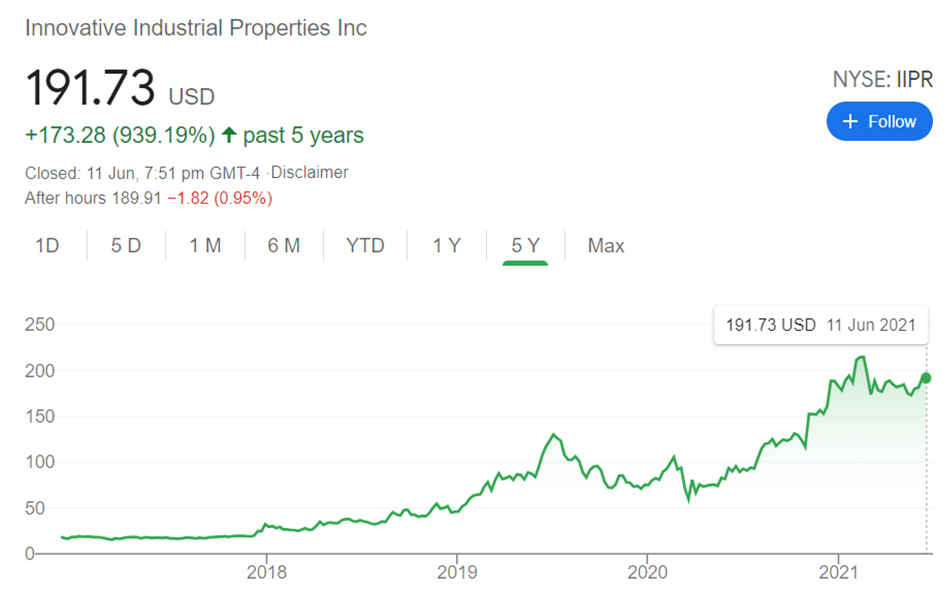
Source: Google
Fig 6: Stock Price of Aurora Cannabis (Canadian Cannabis Producer) – 5 years
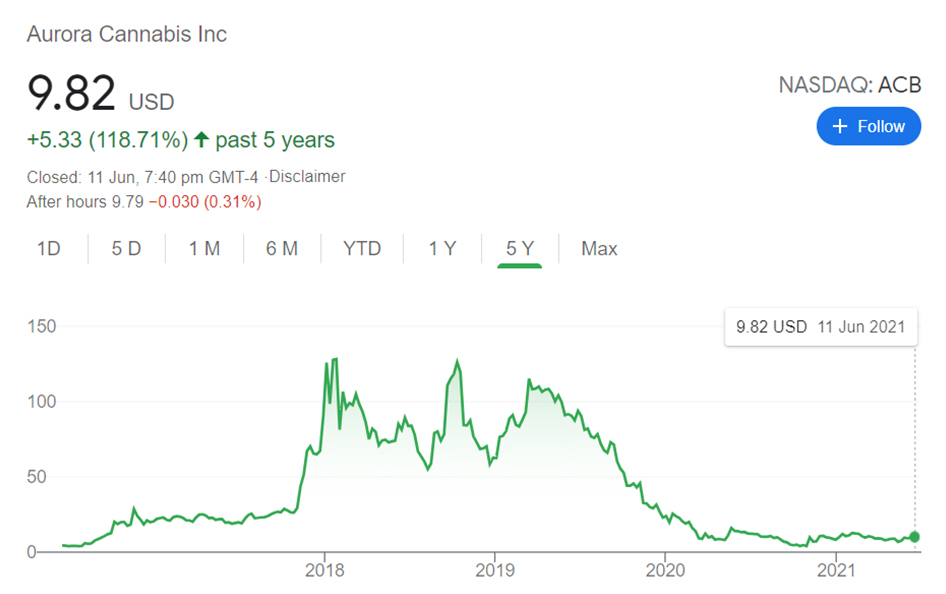
Source: Google
Potential Challenges Facing Marijuana in the EMs
There is no glory without obstacles. And it is no different with marijuana. After battling social stigma and its presence in the banned substance list of many countries around the world, the biggest challenges facing the plant are as follows:
- Regulations- While many countries have legalised marijuana, there is still haze over rules regarding cultivation, possession and usage of marijuana. Governance issues are a major turn off for investors.
- Profit over Patients- Medical marijuana is increasingly becoming commoditized. That many patients have benefited from its usage is well known. But the growing risk is that companies may very well start to put profit over patient’s health.
- Social Stigma- The fact that marijuana had been in the banned list for so long is somewhat of a negative for the crop. Although it is transitory, as marijuana continues to become legalised, for the time being social stigma is a shadow lurking underneath.
The way forward for Marijuana in the EMs
Despite some of the major challenges highlighted above, we think that EMs will play catch up very quickly. In the countries where climatic conditions allow the plant to grow, there will be a quick adoption and we think that even 20% CAGR is a conservative estimate for this decade. From the perspective of institutional investors, some of the important takeaways are as follows:
- There will be more countries who would evaluate decriminalising marijuana and may even encourage its plantation. Ultimately, demand is such a strong driver that once the legal issues with the plant and how it can be used are sorted, supply will come to meet the demand. This is likely to be the case here.
- While medical marijuana is likely to remain a focus area, some of the countries will also see initiatives to push forward towards controlling other usage as well. This will lead to more companies getting into different parts of the value chain. Imagine something very similar to what we see today in coffee, tea, cocoa, palm oil, rubber etc.
- Investor interest is likely to increase over the coming years. But there is something that these marijuana companies will probably struggle with. That’s ESG or getting through the Environmental, Social and Governance filter. Investors are increasingly using ESG as an investment filter and this set of asset managers may show lesser interest in these marijuana companies.
How EMAlpha can Help Investors
The marijuana industry is still in its infancy. Rules are being written along the way. As such, it is too early and too difficult to pinpoint with a reasonable degree of certainty as to which companies or which countries will emerge as potential winners over the next few years and over the longer term. Nonetheless, the important changes and developments that are happening in the space can be tracked to stay abreast of movements.
It does seem like cannabis will become more and more prevalent. Clearly, countries want to cut out the black market and generate taxable income from a plant that has been used for thousands of years. It will take time but if the USA, a typically conservative country on these matters, is already leading from the front, then global adoption is imminent.
- EMAlpha’s AI-ML algorithm allows investors to stay on top of local news like regulations and legislations. The local news flow collection picks up several important issues like what’s happening with local legislation, much faster than English media. The potential fallout of these events is usually better predicted using local news analysis.
- There is no sector in which all companies are good or all the companies are bad and this applies here too. EMAlpha can help in formal objective evaluation of the companies in this sector and this exercise will help investors in figuring out what will work as an investment and what will not.
- There is a side-track in this story from ESG perspective. What will help the supporters is that the plant has an ability play the sustainability theme (growing cannabis uses 10 times less water than traditional crops like cotton). They will surely push this aspect as a no brainer to bring the plant under legislation.
- The behaviour of large institutional investors is influenced by where they stand on issues like impact on society and community. This is useful information because it can help forecast the stock price impact. EMAlpha product combines technology with domain expertise and the analysis by EMAlpha is useful in picking up signals on the views of institutional investors.
References
- Can medical cannabis in Thailand balance profits and patients https://www.eastasiaforum.org/2021/05/13/can-medical-cannabis-in-thailand-balance-profits-and-patients/ (Accessed on 05th June 2021)
- It is now legal to grow six pots of cannabis in Thailand https://www.chiangraitimes.com/lifestyles/its-now-legal-to-grow-six-pots-of-cannabis-in-thailand/ (Accessed on 05th June 2021)
- Peter Thiel gets into the weed business https://www.inc.com/associated-press/peter-thiel-gets-into-the-weed-business.html (Accessed on 05th June 2021)
- Whoopi Goldberg finds medical marijuana for women https://www.usatoday.com/story/money/business/2016/03/30/whoopi-goldberg-founds-medical-marijuana-women/82416612/ (Accessed on 05th June 2021)
- The cannabis empire that earns Mike Tyson $ 1 million….a month https://www.foxsports.com.au/boxing/boxing-news-mike-tysons-cannabis-empire-earns-1-million-a-month-from-selling-weed/news-story/2ddf0341f70ef9419df2b07b6fe0ab78 (Accessed on 05th June 2021)
- Cannabidiol (CBD)- What we know and what we don’t https://www.health.harvard.edu/blog/cannabidiol-cbd-what-we-know-and-what-we-dont-2018082414476 (Accessed on 05th June 2021)
- As NCB continues arrests, India votes at UN to declare cannabis a less dangerous drug https://theprint.in/india/weeks-after-bollywood-drug-arrests-india-votes-to-have-cannabis-de-barred-from-un-convention/557713/ (Accessed on 05th June 2021)
- Cannabis: An economic driver in emerging markets https://forbes.mc/article/cannabis-an-economic-driver-in-emerging-markets (Accessed on 05th June 2021)
- Medical Marijuana https://www.health.harvard.edu/blog/medical-marijuana-2018011513085 (Accessed on 05th June 2021)
- Uruguay: The world’s marijuana pioneer https://www.bbc.com/news/business-47785648 (Accessed on 05th June 2021)
- Cannabis investors eye Uruguay in push for global weed exports https://www.bnnbloomberg.ca/cannabis-investors-eye-uruguay-in-push-for-global-weed-exports-1.1231143 (Accessed on 05th June 2021)
- Argentina seeks to be a regional leader in the production of cannabis https://marketresearchtelecast.com/argentina-seeks-to-be-a-regional-leader-in-the-production-of-cannabis-for-medicinal-and-industrial-purposes/61862/ (Accessed on 05th June 2021)
- An overview of the cannabis tech investment scene in Latin America https://www.nathanlustig.com/an-overview-of-the-cannabis-tech-investment-scene-in-latin-america/ (Accessed on 05th June 2021)
- Hemp goes from zero to economic hero https://www.bangkokpost.com/business/2076111/hemp-goes-from-zero-to-economic-hero (Accessed on 05th June 2021)
- Building a cannabis company without betting on getting customers high https://www.forbesindia.com/article/cross-border/building-a-cannabis-company-without-betting-on-getting-customers-high/67759/1 (Accessed on 05th June 2021)
EMAlpha Products and Services
In most Emerging Markets, information discovery is a major challenge. For example, even if global investors do show interest, how do they solve the problem of timely access to information? The world’s largest capital allocators hold USD 60 trillion and they include GPIF (Japan), GPF (Norway), ADIA (Abu Dhabi), GIC (Singapore) etc. However, only 10% of the capital gets allocated to EMs and ~90% goes to G10. The big hurdle for EMs is: Foreign investors cannot access relevant local information in a timely fashion.
Most market participants and investors from across the world realise that the low rates in G10 makes EM attractive for investors. But, a) Information access is usually a cost and time intensive process for investors, and b) In many EMs, language is a big barrier and because of multiple regional languages, there is a significant delay before news makes it to the mainstream English language. To address these issues, you need solutions like, a) Real time news collection from multiple languages and, b) Instantaneous machine translation and text analytics leading to actionable recommendations for investors.
There are further challenges such as ensuring that companies behave responsibly and that they adopt sustainable business practices. There is a need to ensure that the investors are contributing towards making the world a better place by making investment decisions which reward responsible behaviour of companies. Case in point, ESG (Environmental, Social & Governance) which is increasingly being used as a filter for investment decisions. There are other issues as well such as which data to use and a lack of a standardized framework for evaluation.
Some of these issues are too important to be postponed to a later date and it is in this regard that EMAlpha is making its contribution. EMAlpha has developed a Flexible ESG Framework Management System which is a proprietary technology that makes ESG scores framework agnostic, thus allowing for quick adaptation. In addition, the users decide what matters to them and the EMAlpha system does a classification into E, S, G and more granular categories.
EMAlpha also has solutions for Multilingual data collection and real time targeted information which are based on proprietary processes to collect relevant data across multiple markets. The coverage expands across emerging market equity, currencies and commodities and the work has also been very successful in testing the signals in some key markets for live trading strategies. This is a continuous cycle and a virtuous loop that allows for iterative improvement through AI-human feedback.
With developments in AI and technology in areas like NLP, there are considerable new possibilities to bridge the gap in information between Emerging Markets and the more Developed Markets. This is an area which is turning out to be very exciting because some of the tools mentioned were not available even a couple of years ago. This implies that the evolution in the field will only get faster as time goes on. While the Emerging Markets and the Capital Flow Conundrum is a complex one, there is now much more hope and optimism that with the usage of technology, things will only get better.
At EMAlpha, the ESG team is doing further research on why some issues like Social get more prominence as compared to others like Environmental or Governance issues. To look at specific cases in the context of ESG is a very intense yet interesting exercise and this has been an incredible learning experience for the EMAlpha Research team. The data, information and ratings are a humongous challenge for ESG and it takes time to reach to the depth of the issues as the field is evolving very quickly.
EMAlpha is making a solid contribution in tackling these challenges. EMAlpha has solutions for ESG which are practical, user friendly and although not too simplistic yet easy to use. EMAlpha has developed a Flexible ESG Framework Management System which is a proprietary technology that makes ESG scores framework agnostic, thus allowing for quick adaptation. In addition, the users decide what matters to them and the EMAlpha system does a classification into E, S, G and more granular categories.
We strongly believe that the entire ESG ecosystem requires multiple stakeholders to pull in the right direction in order to make it operational and that will be the most critically determining factor for ESG’s success in making the corporate responsibility actually work. Most importantly, the investors should view ‘E’, ‘S’ and ‘G’ individually and should not confound issues when it comes to the comprehensive ESG evaluation. It is important to understand the right reasons behind ESG investing because this bias could hurt their investment decision making and portfolio performance.
Research Team
EM Alpha LLC
For more EMAlpha Insights on Emerging Markets, please visit https://emalpha.com/insights/. To know how you can use EMAlpha’s unstructured data and ESG (Environmental, Social and Governance) solutions for better investment decisions, please email us at [email protected].
About EMAlpha:
EMAlpha, a data analytics and investment management firm focused on making Emerging Markets (EMs) more accessible to global investors and unlocking EM investing using machines. EMAlpha’s focus is on Unstructured Data as the EMs are particularly susceptible to swings in news flow driven investor sentiment. EMAlpha works on information discovery and ESG solutions for Investors in Emerging Markets, using AI and NLP tech. Our mission is: “To help increase capital flow, in terms of FDI and FPI, to Emerging Markets by lowering information barriers using AI/NLP”. EMAlpha Products help achieve both alpha and ESG solutions and the idea is to help asset allocators, asset managers, banks and hedge funds along with companies with cost and time efficient access to relevant information. We use thoroughly researched machine learning tools to track evolving sentiment specifically towards EMs and EMAlpha pays special attention to the timely measurement of news sentiment for investors as these markets can be finicky and sentiment can be capricious. Our team members have deep expertise in research and trading in multiple Emerging Markets and EMAlpha’s collaborative approach to combining machine learning tools with a fundamental approach help us understand these markets better.
Disclaimer:
This insight article is provided for informational purposes only. The information included in this article should not be used as the sole basis for making a decision as to whether or not to invest in any particular security. In making an investment decision, you must rely on your own examination of the securities and the terms of the offering. You should not construe the contents of these materials as legal, tax, investment or other advice, or a recommendation to purchase or sell any particular security. The information included in this article is based upon information reasonably available to EMAlpha as of the date noted herein. Furthermore, the information included in this site has been obtained from sources that EMAlpha believes to be reliable; however, these sources cannot be guaranteed as to their accuracy or completeness. Information contained in this insight article does not purport to be complete, nor does EMAlpha undertake any duty to update the information set forth herein. No representation, warranty or undertaking, express or implied, is given as to the accuracy or completeness of the information contained herein, by EMAlpha, its members, partners or employees, and no liability is accepted by such persons for the accuracy or completeness of any such information. This article contains certain “forward-looking statements,” which may be identified by the use of such words as “believe,” “expect,” “anticipate,” “should,” “planned,” “estimated,” “potential,” “outlook,” “forecast,” “plan” and other similar terms. Examples of forward-looking statements include, but are not limited to, estimates with respect to financial condition, results of operations, and success or lack of success of certain investment strategy. All are subject to various factors, including, but not limited to, general and local economic conditions, changing levels of competition within certain industries and markets, changes in interest rates, changes in legislation or regulation, and other economic, competitive, governmental, regulatory and technological factors affecting the operations of the companies identified herein, any or all of which could cause actual results to differ materially from projected results.



